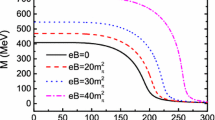Abstract
Relativistic mean field theory with mesons σ, ω, π and ρ mediating interactions and nucleons as basic fermions has been very successful in describing nuclear matter and finite nuclei. However, in heavy-ion collisions, where the c. m. energy of two colliding nucleons will be in the hundreds of GeV region, nucleons are not expected to behave as point-like particles. Analyses of elastic pp and ¯pp scattering data in the relevant c. m. energy range show that the nucleon is a composite object—a topological soliton or Skyrmion embedded in a condensed quark-antiquark ground state. Against this backdrop, we formulate an effective field theory model of nuclear matter based on the gauged linear σ-model where quarks are the basic fermions, but the mesons still mediate the interactions. The model describes the nucleon as a Skyrmion and produces a q¯q ground state analogous to a superconducting ground state. Quarks are quasi-particles in this ground state. When the temperature exceeds a critical value, the scalar field in the ground state vanishes, quarks become massless, and a chiral phase transition occurs leading to chiral symmetry restoration. We explore the possibility of a first order phase transition in this model by introducing suitable self-interactions of the scalar field. Internal structures of the Skyrmions are ignored, and they are treated as point-like fermions.
Similar content being viewed by others
REFERENCES
T. Matsui, Quark Matter '97: Nucl. Phys. A 638, 19c (1998).
J. W. Harris and B. Müller, Annu. Rev. Nucl. Part. Sci. 46, 71 (1996).
W. Cassing and E. L. Bratkovskaya, Phys. Rep. 308, 65 (1999).
H. Sorge, H. Stöcker, and W. Greiner, Ann. Phys. 192, 266 (1989). A. Jahns, H. Sorge, H. Stöcker, and W. Greiner, Z. Phys. A 341, 243 (1992).
S. H. Kahana, D. E. Kahana, Y. Pang, and T. J. Schlagel, Annu. Rev. Nucl. Part. Sci. 46, 31 (1996).
B. A. Li and C. M. Ko, Phys. Rev. C 52, 2037 (1995).
Y. Nambu and G. Jona-Lasinio, Phys. Rev. 122, 345 (1961). 124, 246 (1961).
T. Hatsuda and T. Kunihiro, Phys. Rep. 247, 221 (1994).
G. Ripka, Quarks Bound by Chiral Fields (Oxford University Press, 1997).
P. Papazoglou, J. Schaffner, S. Schramm, D. Zschiesche, H. Stöcker, and W. Greiner, Phys. Rev. C 55, 1499 (1997).
R. J. Furnstahl, H. B. Tang, and B. D. Serot, Phys. Rev. C 52, 1368 (1995).
G. Boyd, J. Engels, F. Karsch, E. Laermann, C. Legeland, M. Lütgemeier, and B. Petersson, Nucl. Phys. B 469, 419 (1996).
E. Laermann, Lattice '97: Nucl. Phys. B (Proc. Suppl.) 63A, 114 (1998).
J. D. Walecka, Theoretical Nuclear and Subnuclear Physics (Oxford Univ. Press, 1995).
B. D. Serot and J. D. Walecka, Int. J. Mod. Phys. E 6, 515 (1997).
M. M. Islam, V. Innocente, T. Fearnley, and G. Sanguinetti, Europhys. Lett. 4, 189 (1987).
M. M. Islam, Z. Phys. C 53, 253 (1992).
M. M. Islam, Proceedings of the Workshop on Quantum Infrared Physics, H. M. Fried and B. Müller, eds. (World Scientific, 1995), p. 401.
Ö. Kaymakcalan, S. Rajeev, and J. Schechter, Phys. Rev. D 30, 594 (1984). Ö. Kaymakcalan and J. Schechter, Phys. Rev. D 31, 1109 (1985).
M. Bando, T. Kugo, S. Uehara, K. Yamawaki, and T. Yanagida, Phys. Rev. Lett. 54, 1215 (1985). M. Bando, T. Kugo, and K. Yamawaki, Phys. Rep. 64, 217 (1988).
S. Callan, S. Coleman, J. Wess, and B. Zumino, Phys. Rev. 177, 2247 (1969).
Ulf-G. Meissner, N. Kaiser, A. Wirzba, and W. Weise, Phys. Rev. Lett. 57, 1676 (1986). Ulf-G. Meissner, N. Kaiser, and W. Weise, Nucl. Phys. A 466, 685 (1987).
W. N. Cottingham, D. Kalafatis, and R. Vinh Mau, Phys. Rev. Lett. 73, 1328 (1994). W. N. Cottingham and R. Vinh Mau, J. Phys. G 24, 1227 (1998).
R. Friedberg and T. D. Lee, Phys. Rev. D 15, 1694 (1977). D 16, 1096 (1977). D 18, 26323 (1978). L. Wilets, in Chiral Solitons, K. F. Liu, ed. (World Scientific, 1987). T. D. Lee and Y. Pang, Phys. Rep. 221, 251 (1992).
J. Boguta and A. R. Bodmer, Nucl. Phys. 292, 403 (1977).
Y. K. Gambhir, P. Ring, and A. Thimet, Ann. Phys. 198, 132 (1990).
E. Witten, Nucl. Phys. B 223, 422, 433 (1983).
P. Jain, R. Johnson, Ulf-G. Meissner, N. W. Park, and J. Schechter, Phys. Rev. D 37, 3252 (1988). Ulf-G. Meissner, N. Kaiser, H. Weigel, and J. Schechter, Phys. Rev. D 39, 1956 (1989).
L. Zhang and N. C. Mukhopadhyay, Phys. Rev. D 50, 4668 (1994).
For a recent review see: J. Schechter and H. Weigel, The Skyrme Model for Baryons, to appear in INSA-BOOK-2000, hep-ph/9907554.
R. Alkofer, H. Reinhardt, and H. Weigel, Phys. Rep. 265, 139 (1996). C. V. Christov et al., Prog. Part. Nucl. Phys. 37 91 (1996). R. Alkofer and H. Reinhardt, Chiral Quark Dynamics (Springer-Verlag, Berlin, 1995), and references therein.
M. M. Islam, Proceedings of the Workshop on Quantum Chromodynamics, H. M. Fried and B. Müller, ed. (World Scientific, 1999), p. 119.
V. A. Miransky, Dynamical Symmetry Breaking in Quantum Field Theories (World Scientific, 1993).
M. Harada, F. Sannino, J. Schechter, and H. Weigel, Phys. Lett. B 384, 5 (1996).
R. D. Pisarski and F. Wilczek, Phys. Rev. D 29, 338 (1984). F. Wilczek, Int. J. Mod. Phys. A 7, 3911 (1992). K. Rajagopal and F. Wilczek, Nucl. Phys. B 399, 395 (1993).
Author information
Authors and Affiliations
Rights and permissions
About this article
Cite this article
Islam, M.M., Weigel, H. An Effective Field Theory Model to Describe Nuclear Matter in Heavy-Ion Collisions. Foundations of Physics 30, 577–597 (2000). https://doi.org/10.1023/A:1003672913006
Issue Date:
DOI: https://doi.org/10.1023/A:1003672913006




